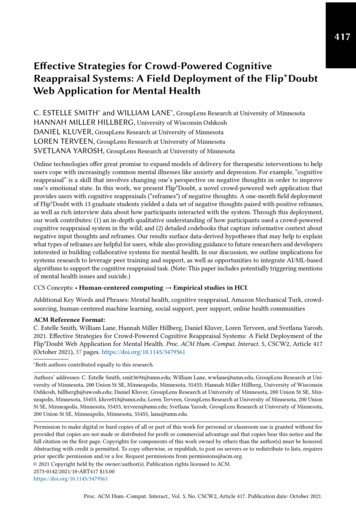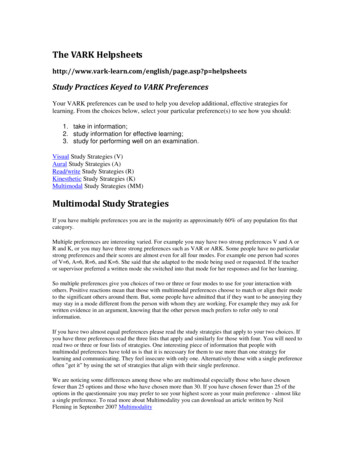
Transcription
417Effective Strategies for Crowd-Powered CognitiveReappraisal Systems: A Field Deployment of the Flip*DoubtWeb Application for Mental HealthC. ESTELLE SMITH and WILLIAM LANE , GroupLens Research at University of MinnesotaHANNAH MILLER HILLBERG, University of Wisconsin OshkoshDANIEL KLUVER, GroupLens Research at University of MinnesotaLOREN TERVEEN, GroupLens Research at University of MinnesotaSVETLANA YAROSH, GroupLens Research at University of MinnesotaOnline technologies offer great promise to expand models of delivery for therapeutic interventions to helpusers cope with increasingly common mental illnesses like anxiety and depression. For example, “cognitivereappraisal” is a skill that involves changing one’s perspective on negative thoughts in order to improveone’s emotional state. In this work, we present Flip*Doubt, a novel crowd-powered web application thatprovides users with cognitive reappraisals (“reframes") of negative thoughts. A one-month field deploymentof Flip*Doubt with 13 graduate students yielded a data set of negative thoughts paired with positive reframes,as well as rich interview data about how participants interacted with the system. Through this deployment,our work contributes: (1) an in-depth qualitative understanding of how participants used a crowd-poweredcognitive reappraisal system in the wild; and (2) detailed codebooks that capture informative context aboutnegative input thoughts and reframes. Our results surface data-derived hypotheses that may help to explainwhat types of reframes are helpful for users, while also providing guidance to future researchers and developersinterested in building collaborative systems for mental health. In our discussion, we outline implications forsystems research to leverage peer training and support, as well as opportunities to integrate AI/ML-basedalgorithms to support the cognitive reappraisal task. (Note: This paper includes potentially triggering mentionsof mental health issues and suicide.)CCS Concepts: Human-centered computing Empirical studies in HCI.Additional Key Words and Phrases: Mental health, cognitive reappraisal, Amazon Mechanical Turk, crowdsourcing, human-centered machine learning, social support, peer support, online health communitiesACM Reference Format:C. Estelle Smith, William Lane, Hannah Miller Hillberg, Daniel Kluver, Loren Terveen, and Svetlana Yarosh.2021. Effective Strategies for Crowd-Powered Cognitive Reappraisal Systems: A Field Deployment of theFlip*Doubt Web Application for Mental Health. Proc. ACM Hum.-Comput. Interact. 5, CSCW2, Article 417(October 2021), 37 pages. https://doi.org/10.1145/3479561 Bothauthors contributed equally to this research.Authors’ addresses: C. Estelle Smith, smit3694@umn.edu; William Lane, wwlane@umn.edu, GroupLens Research at University of Minnesota, 200 Union St SE, Minneapolis, Minnesota, 55455; Hannah Miller Hillberg, University of WisconsinOshkosh, hillbergh@uwosh.edu; Daniel Kluver, GroupLens Research at University of Minnesota, 200 Union St SE, Minneapolis, Minnesota, 55455, kluve018@umn.edu; Loren Terveen, GroupLens Research at University of Minnesota, 200 UnionSt SE, Minneapolis, Minnesota, 55455, terveen@umn.edu; Svetlana Yarosh, GroupLens Research at University of Minnesota,200 Union St SE, Minneapolis, Minnesota, 55455, lana@umn.edu.Permission to make digital or hard copies of all or part of this work for personal or classroom use is granted without feeprovided that copies are not made or distributed for profit or commercial advantage and that copies bear this notice and thefull citation on the first page. Copyrights for components of this work owned by others than the author(s) must be honored.Abstracting with credit is permitted. To copy otherwise, or republish, to post on servers or to redistribute to lists, requiresprior specific permission and/or a fee. Request permissions from permissions@acm.org. 2021 Copyright held by the owner/author(s). Publication rights licensed to ACM.2573-0142/2021/10-ART417 15.00https://doi.org/10.1145/3479561Proc. ACM Hum.-Comput. Interact., Vol. 5, No. CSCW2, Article 417. Publication date: October 2021.
417:21Smith & Lane, et al.INTRODUCTIONRoughly 1 in 5 Americans meet the criteria for at least one mental illness [13]. In some populations,these rates are even higher; for example, 41% of graduate students report moderate to severe anxietyand 39% report similar levels of depression [25, 27]. Unfortunately, there are nowhere near enoughclinical resources available to meet ever-growing demand for treatment, due not only to a lack ofproviders, but also to a widespread lack of access to adequate transportation, health insurance orfinances [78]. Stigma around seeking professional mental health care adds an additional barrier,with minority racial groups, immigrants, and people of low socioeconmic status even less likely toseek care [44]. Therefore, it has become vitally important to consider new ways to expand modelsof delivery for therapeutic interventions beyond individual or group therapy with clinical, licensedpsychotherapists [44]. In particular, the psychology [44, 77] and social computing [4, 24, 67, 68]literature strongly advocate for a need to involve well-intentioned peers (e.g., friends, family,community volunteers, or other strangers online) in mental health interventions, even withoutprofessional training or knowledge, both because peers are particularly well-positioned to providesupport, and because peer support is often crucial or necessary for recovery.Technology may offer effective and scalable ways to involve peer supporters and and offer skillsbased training to address gaps in mental healthcare through Internet use [44], mobile apps [56, 85],online or telephone counseling [44, 76], or online health communities [6, 18, 74, 81, 88, 89]. One suchopportunity leverages “cognitive reappraisal” [5, 24, 56]–a skill for regulating emotions by changingone’s thoughts about the meaning of a situation [36]. Using this skill effectively requires trainingand practice [96] that is ideally provided in clinical settings like Cognitive Behavioral Therapy(CBT) [80] or Dialectical Behavioral Therapy (DBT) groups [11]. Yet insufficient clinical accessleaves a gap that technology might fill. For instance, crowd-powered cognitive reappraisal platformsshows promise in delivering timely, user-specific reframes [59, 60]. The eventual intention of suchplatforms is to help users become proficient in reappraising their own thoughts, however twointermediary goals approach this aim. First, receiving a meaningful reappraisal may be helpful in themoment and serve as a model for someone new to the technique [59]. Second, providing reappraisalsto others benefits the re-appraiser through repetitive practice [5, 24]. One major sociotechnicalchallenge lies in resolving the tension between the two goals—providing minimally-trained novicere-appraisers with opportunities to practice and improve, while still ensuring quality responses forthose seeking reappraisals.Artificial Intelligence and Machine Learning (AI/ML)-based algorithms present opportunitiesfor augmenting cognitive reappraisal platforms by providing a scaffold for moderating and/ortraining novice re-appraisers. For example, content moderation algorithms can amplify moderatorefforts and prevent users from receiving harmful reappraisals. Additionally, AI-based generativemodels and recommender systems could help re-appraisers select effective reappraisal strategiesfor specific users or situations. Capitalizing on these opportunities requires collecting and labelingdomain-specific datasets. Furthermore, prior work points to needs for an empirical understandingof: (1) how such systems are used in the wild without extensive training for re-appraisers andminimal moderation, and (2) whether certain reappraisal strategies are more useful than others,given varying user contexts. We frame these areas of inquiry as two driving research questions:RQ1: How do people use a crowd-powered cognitive reappraisal application in the wild?RQ2: How do contextual factors impact participant perceptions of the quality of reappraisalsthey receive through a crowd-powered reappraisal system?In order to address these questions, we built a crowd-powered cognitive reappraisal prototypecalled Flip*Doubt. We completed a month-long field deployment with 13 graduate student participants to collect complementary qualitative and quantitative data. Through a thematic data-drivenProc. ACM Hum.-Comput. Interact., Vol. 5, No. CSCW2, Article 417. Publication date: October 2021.
Effective Strategies for Crowd-Powered Cognitive Reappraisal Systems417:3analysis, we contribute an understanding of how participants used the system in the wild, and twocodebooks that provide a new way for researchers to label contextual aspects of negative thoughtsand corresponding cognitive reappraisals. Furthermore, our results surface hypotheses about howthese contextual aspects impact perceptions of quality. In our discussion, we outline implicationsfor systems research to leverage peer training and support, as well as opportunities to integrateAI/ML-based algorithms to support the cognitive reappraisal task. We also offer strategies andethical considerations for future work to gather large cognitive reappraisal datasets that couldsupport the development of the proposed AI/ML-based systems.2RELATED LITERATUREMany studies have examined mental health intervention technologies from the perspective ofbehavior intervention (e.g., [55, 72, 97]) and therapeutic content delivery (e.g., [21, 31, 85]), withmany acknowledging the need for additional work on improving engagement [20, 94] and personalization [2, 61, 71, 93]. In this paper, we support such opportunities by examining how a crowd-basedcognitive reappraisal platform is used in the wild, and analyzing data generated through deployment.In this section, we position these contributions in the context of prior literature on emotion regulation, behavior intervention technologies, crowd-powered cognitive reappraisal, and algorithmicscaffolding for supportive messaging and moderation in mental health.2.1Emotion regulation and cognitive reappraisal2.1.1 Cognitive reappraisal as a skill. Our paper explores the potential for crowd-based technologiesto support skill-building for emotion regulation. More specifically, cognitive reappraisal is a skillthat requires a person to reflect on the emotional meaning of a situation [36] in order to upregulate positive emotions or down-regulate negative emotions [54]. Using this skill effectivelyfirst requires modeling, training, and practice [96], and can then reduce emotional distress [37] anddepression [33]. However, learning and applying the skill can be quite difficult, especially duringmoments of elevated stress [75].2.1.2 The need to understand context-specific reappraisal tactics. One specific challenge is thatcognitive reappraisal is sensitive to contextual details [95] and timing [87], which makes it difficultto provide one-size-fits-all training for generating or evaluating reappraisals. Most relevant to thisstudy, prior work has taken initial steps to identify tactics for supporting people to generate betterreappraisals. In “Unpacking Cognitive Reappraisal: Goals, Tactics, and Outcomes,” [53] McRae et al.created a codebook that detailed eight types of reappraisal tactics that people used for emotionregulation. Furthermore, Morris et al. highlight the need for future work to explore “whether specificreappraisal tactics might be solicited at different times, perhaps depending on user preference or thenature of the user’s situation.” [59] To address this open question, we adapt the codebook from [53]for a crowd-based online cognitive reappraisal task. We also contribute new codes for contextualfeatures of negative thoughts and “meta-behaviors” used by crowd-workers.2.2Behavior Intervention Technology2.2.1 Behavior intervention through digitizing therapeutic content. Crowd-based systems for cognitive reappraisal fall into the broader class of systems known as Behavior Intervention Technologies(BITs). In HCI, BITs have been effectively used to aid users with goals like smoking cessation [15],weight management [8], and reduction of anxiety and depression in primary care settings [35] andstudent populations [60]. Mental health BITs cover a broad array of technologies ranging from simple supportive messaging systems like Text4Mood [1] to multi-app suites like IntelliCare [56] thatoffer skills-based therapeutic content. Of particular relevance to this study are apps that translateProc. ACM Hum.-Comput. Interact., Vol. 5, No. CSCW2, Article 417. Publication date: October 2021.
417:4Smith & Lane, et al.therapeutic modalities into online formats. Two examples include: “iCBT,” in which professionaltherapists work with CBT clients fully online [20]; and “Pocket Skills,” a mobile app that introduceseMarsha (modeled after DBT’s founder, Marsha Linehan) as a chat agent to guide users throughvirtual DBT exercises [85]. Both examples expand access to digitized modules for emotion regulation, distress tolerance, interpersonal effectiveness, or other types of skills, which form the the corematerials and concepts of CBT/DBT. However, they do not yet incorporate peer support, which,for many clients, is equally as important as the core content [77]. The complexity and nuance ofinvolving peers safely and effectively through online interventions remains an unsolved challengethat our work here contributes toward solving.2.2.2 A need for more personalization and peer involvement. Another core challenge is that BITstypically attempt to replace or augment the training a participant may receive under the supervisionof a professional therapist [80]. Prior work has taken several approaches to address this. Oneapproach is to apply a broad set of heuristic best practices for the cognitive reappraisal task. Forexample, IntelliCare Thought Challenger [56] first directs users to input a negative thought. It thenprovides a set of general questions to help them identify distortions in the thought, and eventuallycraft a more helpful or realistic version of the original. However, this heuristic approach is notpersonalized to the user or context. A substantial body of work has highlighted the need for suchpersonalization as an area for future research in the study of mental health BITs (e.g., [59, 71, 72, 93]),as well as the vital need to incorporate peer supporters [4, 24, 44, 67, 68]. Crowdsourcing is thus asecond approach that can help to leverage peer support, provide users with personalized reframes,and scale BITs outside of the supervision of professional therapists. Flip*Doubt takes this strategy,inspired by prior research on crowdsourcing in mental health BITs.2.3Crowdsourcing in behavior intervention technologies2.3.1 Prior systems for crowd-powered support. In crowdsourcing, large groups of people (usuallystrangers online) individually complete small tasks that contribute to larger goals [69], like writingdocuments [10], evaluating trustworthiness on Wikipedia [45], or labelling training data [50].Panoply is one especially relevant example of a mental health BIT that uses crowdsourcing. Panoplybegan as a research project [59, 60] and has since been developed into a nonprofit called Kokothat is primarily used by adolescents and young adults [23, 24, 58]. In Panoply/Koko, users input adescription of their stressor. The system sends that description to a crowd worker, who then sendsa supportive message back to the user. Morris et al. found that using Panoply to receive supportivemessages helped reduce depression symptoms [60], and also that clinically beneficial effects wereeven more pronounced when Koko users actively participated in sending positive support messagesto others [24]. Panoply used two mechanisms to ensure quality reappraisals: (1) it provided trainingin cognitive reappraisal to crowd workers on Amazon Mechanical Turk (AMT); and (2) it employeda second layer of crowd workers to moderate the quality of reappraisals–i.e. to check for grammarand language issues, and ensure core issues of the input stressor were addressed.2.3.2 Assessing quality in crowd-powered cognitive reappraisal. Our system is inspired by thePanoply approach, but differs in several ways to allow us to address our research questions. First,beyond a basic description of the task, we use untrained crowd workers. This enables us to gatherdata that models the behavior of “in the wild” users, such as those who might arrive to onlinecommunities for mental health with no prior training. (Note that Koko shifted to using online peersrather than AMT workers, and like Flip*Doubt, also offers almost no training, making the Kokoplatform a close comparison.) Second, we ask participants to assess the quality of all reappraisals(rather than allowing moderators to filter any responses) based on their own subjective experienceof what is perceived as “helpful” to them on a 0.5-5 star rating scale. We contrast our rating scaleProc. ACM Hum.-Comput. Interact., Vol. 5, No. CSCW2, Article 417. Publication date: October 2021.
Effective Strategies for Crowd-Powered Cognitive Reappraisal Systems417:5against the one used in Koko, which asks recipients of support messages to use a 3-point ratingscale (-1 it’s really bad, 0 it’s okay, 1 it’s really good) [23]. We intentionally did not includelabels on our rating scale or provide a specific definition of “bad” or “good” reframes during ourintake procedure, so that participants could organically form their own opinions of what is helpful,and then share their reasons for why/how they provided reframe ratings. In doing so, our workcontributes a nuanced and user-derived understanding of “quality” in crowd-based reappraisals, andhelps to identify types of unhelpful reappraisals that may otherwise pass moderated quality checks(e.g., Pollyannaisms). Identifying contextual factors associated with both helpful and unhelpfulresponses lays the groundwork for systems that scaffold both reappraisal and moderation processes.2.4Algorithmic scaffolding for supportive messaging and moderationOne final approach to scaling mental health behavior intervention technologies relies on semior fully automated solutions to assist peer supporters to write high quality comments, and/ormoderators to manage a much higher volume of peer-written messages. To support these goals,recent studies seek to understand: (1) what factors contribute to the effectiveness of peer supportmessages; and (2) how technology might better guide supportive peer communications.2.4.1 Qualities of effective support messages. Some recent works use ML/NLP methods to createmodels from observed data in online communities (such as words or behavioral logs), with thegoal of uncovering features of high quality supportive messages. For example, Bao et al. presenteight broad categories of pro-social behavior (information sharing, gratitude, esteem enhancement,social support, social cohesion, fundraising/donating, mentoring, and absence of toxicity), as wellas automatic methods for extracting information about each category from Reddit data [7]. Morespecific to mental health, Chikersal et. al. describe a text-mining procedure in which they extractlinguistic features from therapists’ messages to clients in an online iCBT platform, and use thesefeatures to predict client outcomes–e.g., reductions in PHQ-9 (depression) and GAD-7 (anxiety)scores (the same clinical measures used in this paper) [20]. The authors conclude that supportivemessages from online therapists are more effective when they follow patterns such as using morepositive and joy-related words than negative and sadness- or fear-related words, and when theycontain more active verbs and social-behavior-related words, with fewer abstraction-related words.Using similar text-mining techniques, Doré and Morris examined Koko data to show that a moderate(rather than low or high) degree of textual similarity between input thoughts and positive supportmessages predicts better ratings of support messages, and also that high semantic synchrony(rather than just similar word choices) predicts even better ratings and longer-lasting emotionalbenefits [23]. However, these papers do not qualitatively analyze the content of reappraisal messages.Rather than extraction through text-mining, we use human induction to create and apply codebooksthat paint a rich, qualitative glimpse of the data. We hope that the insights from our study willeventually enable a finer degree of granularity for personalized, strategic recommendations thatcan complement broader stylistic recommendations from prior work.2.4.2 Technology for guiding supportive communication. Some prior work explores technologicalmechanisms for guiding peer conversations. For example, O’Leary et al. designed a guided chatexercise with pre-defined prompts for pairs of participants to discuss mental health issues [68];guided chats promoted more depth, insights, and solutions, whereas unguided chats felt smootherand offered pleasant distractions, albeit with less depth. Other papers focus matching chat partners.For example, Andalibi & Flood interviewed users of Buddy Project, which connects anonymousyouths struggling with mental health [4]. Unlike physical illnesses such as cancer [32, 51, 89] or rarediseases [52], where research has established that matching based on condition is a crucial goal, [4]found that users should be paired based on shared interests or identity, rather than mental healthProc. ACM Hum.-Comput. Interact., Vol. 5, No. CSCW2, Article 417. Publication date: October 2021.
417:6Smith & Lane, et al.diagnoses, since over-exposure to the same mental illness can lead to unhealthy comparisons ordisordered coping mechanisms. O’Leary et al. also affirm the necessity of matching peers based onsimilarities beyond mental health diagnosis, as well as improving the accessibility of interventions,and proactively providing training to users in order to mitigate risks [67].Recent work also highlights an urgent need for online communities to provide technologicalhelp with writing individual comments [88]. Through focus groups with stakeholders in a largeonline health community (www.CaringBridge.org), Smith et al. show that users often struggleto know what to say, and that they desire mechanisms such as algorithmic assistance, trainingresources, or automatic text suggestions to help them compose effective messages [88]. Somework has begun to implement such algorithmic assistance. For example, Sharma et. al. built aReinforcement Learning-based agent (PARTNER) that generates and inserts more empatheticphrases into commments [86]. Peng et al. created the Mental Health Peer Support Bot (MepsBot)which helps peers to improve supportive comments by either assessing in-progress commentsand highlighting improvement opportunities, or recommending prior comments as examples [73].Relatedly, Morris et al. conducted a study in which they matched incoming Koko posts with similarpast posts, and then sent pre-existing comments written by past peers [58]. Framing re-usedcomments as though they were from by a bot, they found that purportedly bot-written commentswere often well-received, but also that they received overall lower ratings than comments fromhuman peers [58]. These types of mechanisms point to possible applications of our results fromFlip*Doubt, as we will describe in the discussion.Finally, algorithmic assistance is now crucial for content moderation in many online contexts. Inlarge communities like Reddit [19, 42] and Wikipedia [34, 38, 91], content moderation systems oftenuse moderator-configured pattern-matching rules or AI/ML-based systems to detect problems likeabusive content or toxic speech [98]. Similarly, Morris et al. call for automated systems that “groomresponses from the crowd” [59] to identify helpful vs. unhelpful responses. This paper contributesanalyses that specify what may be helpful or unhelpful for cognitive reappraisal. We next describethe system and methods used to address these open areas of inquiry.3SYSTEM DESIGNThe title of Flip*Doubt is a phonetic play on words. The phrase “flipped out” refers to a negativemental state such as overwhelming anxiety, fear, or doubt; the Flip*Doubt system helps to “flip”these “doubts” or negative thoughts. Similar to Koko, the system prompts users to input negativethoughts, and then uses crowdsourcing techniques to return cognitive reappraisals back to the user.We will use the following terms throughout the rest of the paper: Input Thought: A negative thought written by the user as input to the system. Reframe: A cognitive reappraisal written by a crowd worker and returned to the user. Tactic: A strategy or approach to cognitive reappraisal used by a crowd worker to generatea given reframe. Reason: An explanatory reason provided by users (either via UI or exit interview) for howthey rated a reframe.3.1Technical detail3.1.1 User Experience & Interface. We designed three main tasks for users in the Flip*Doubt webapplication: (1) creating input thoughts, (2) rating reframes, and (3) providing reasons. Figure 1shows two main screens of Flip*Doubt. For task (1), the "Write Thoughts" screen displayed a thoughtbubble with an input field. Rather than notifying participants at specified times, we instructedthem to organically input negative thoughts whenever they felt comfortable sharing them for thisProc. ACM Hum.-Comput. Interact., Vol. 5, No. CSCW2, Article 417. Publication date: October 2021.
Effective Strategies for Crowd-Powered Cognitive Reappraisal Systems417:7Fig. 1. Flip*Doubt Web Application Screenshots. Left: The “Write Thoughts” screen shows a text input fieldshaped like a thought bubble containing a prompt for the user to type in a negative thought. Right: The “RateReframes” screen allows users to view an input and rate its three reframes on a 0.5-5 scale star rating system.research. This choice provided the benefit of allowing natural system usage, with the limitationthat some users did not use it as regularly as others.Next, clicking a button labeled "Transform" sent the thought to Amazon Mechanical Turk (AMT).We retrieved three reframes from AMT crowd workers for each input thought (see Sec. 3.1.3).Participants received an email when all three reframes were complete. Most reframes were returnedwithin about 3-10 minutes, or on rare occasions, a few hours. Participants then returned to theapplication to complete tasks (2) and (3) in the "Rate Reframes" screen, which presented a scrollableview of reframes ready to be rated. To avoid accidental 0-star ratings from not clicking anything,we required each reframe to be rated on a 0.5 to 5 star scale. After providing all three ratings, anadditional input box appeared and prompted the user to provide a reason for one of the ratings.1Finally, the user was presented with a flippable digital card. On the front, the top-rated reframewas overlaid on a randomly selected nature or cityscape to resemble a "motivational poster." On theback, the input was overlaid on a dark photo. Participants could return to flip the cards at any time.3.1.2 Backend. Flip*Doubt was a web application built on the MERN stack (Mongo, Express, Reactand Node). The application was deployed on Heroku and utilized the AMT API to create HumanIntelligence Tasks (HITs) when users generated input. One node.js process continuously polledthe AMT API to retrieve reframes and persist them in the MongoDB instance. The Flip*Doubt webserver then continuously polled the MongoDB instance for newly persisted reframes returned fromAMT, to present in the React application.3.1.3 Crowdsourcing integration. Three identical HITs were created on AMT per one input. HITsincluded minimal instructions to view the input and write a reframe that is more positive andinspirational. The HIT instructions (available in Appendix section B) also included one examplecase of an input with two acceptable and two unacceptable reframes. No information or trainingwas provided to crowd workers. We paid 0.05 USD per HIT.4METHODSWe completed a field study of Flip*Doubt with graduate students from across several departmentsat the University of Minnesota during February through May of 2019. Here, we describe our1 We asked for only one reason (despite having three reframe ratings) to avoid fatiguing users. We gathered an approximatelyequal number of reasons across each possible rating level by implementing an algorithm to request a reason for the ratinglevel for which we had collected the fewest ratings. For example, if a user rated three reframes at 1.5, 3.0, and 4.5 stars, andwe had previously collected the least reasons for 3.0 star ratings, the system would request a reason for the 3.0 star rating.Proc. ACM Hum.-Comput. Interact., Vol. 5, No. CSCW2, Article 417. Publication date: October 2021.
417:8Smith & Lane, et al.participants and the four-stage protocol we used to gather and ensure data quality and participantsafety. We then describe our analysis of the data.4.1ParticipantsGraduate students are highly impacted by mental illnesses like anxiety and depression [25, 27]or imposter syndrome [79]—a damaging and persistent pattern of thinking that one is fraudulentcompared to peers [14]. We emailed two departmental list-servs and invited respondents to recommend friends. We recruited a snowball sample of thirteen students (four MS, nine PhD) from fivedifferent departments and degree programs. Eight participants identified as female, five as male.Seven participants reported never receiving a mental health diagnosis from a medical professional;five reported that they had; one did not say. Participants’ ages ranged from 24 to 39 (average 30.6)years old. Participants reported their race as White (10), Black (1), Asian (1), a
one’s emotional state. In this work, we present Flip*Doubt, a novel crowd-powered web application that provides users with cognitive reappraisals (“reframes") of negative thoughts. A one-month field deployment of Flip*Doubt with 13 graduate students yielded a dat










